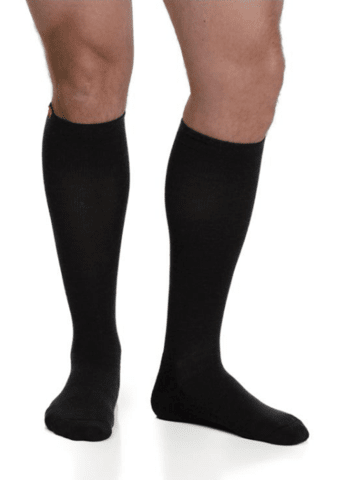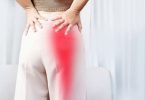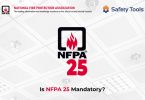Compression stockings are an amazing technological innovation that not only improves blood circulation, but also provides comfort, prevents swelling, and eases pain in your legs and feet.
But how do they work? How effective they really are? Keep reading to get your answers!
How Do Compression Socks Work
Think about the veins in your body. What do they do? Veins basically circulate blood around your body with the help of the valves in them. But these valves have an additional challenge i.e. they must push blood upstream, fighting against gravity.

Over the years, these valves can become weak or damaged due to repeatedly performing this activity. As a result, blood pools in the lower leg and forms bulging dark veins beneath the skin called varicose veins. These veins make the legs feel painful, heavy, tired or itchy. What’s worse is that if left untreated, developing conditions like venous ulcers or blood clots is highly likely.
This is where compression socks come to work. Compression socks promote regular healthy flow of blood by giving the vein valves the boost they need. This useful legwear puts gradual amounts of pressure in the leg, especially at the bottom. The pressure from the socks pushes the blood up the leg. It remarkably treats varicose veins in a process in which little pain or heaviness is felt in the legs. But, it must be kept in mind that compression socks aren’t an ultimate cure for varicose veins.
Overall, compression socks:
- Minimize the diameter of major veins by surging the velocity and volume of the flow of blood.
- Boosts blood flow upwards in the direction of the heart
- Stops blood from refluxing down to the foot or in the superficial veins (laterally)
Compression socks and stockings: are they the same?
Before we begin, it’s important to know that both compression socks and stockings are the same when it comes to the compression or mmHg levels. A 15-20mmHg compression stock would exert the same pressure on your leg as a 15-20 mmHg compression stocking.

However, the differences come down to the material and design. Generally, compression stockings are of knee length, hosiery style or thigh high length. Some can even have an open toe. On the contrary, compression socks come typically in knee high length or ankle length, with a closed toe.
Benefits of wearing compression socks
- Improves circulation
- Improves lymph drainage
- Protects muscles
- Enhances performance
- Slower athletes may benefit more from a circulatory effect
Runners
In a runner’s body, lactic acid tends to build up quickly in the calves due to the strainful long hours of running. But when compression socks are worn, the high speed at which they run can cause this acid to flow up to the heart much faster with blood, reducing any painful muscle sore that the runner may face in the days following their big run.
Compression in the socks highly reduces movements in the calf muscles, preventing the legs from tiring out in a short time. Any swelling in the feet, legs or ankles can be controlled by wearing compression socks as they squeeze around these areas to prevent the possible build-up of any fluid in the tissue.
One study found that wearing compression socks for 48 hours following a marathon boosted performance on a treadmill test after just two weeks.
Football players
From clinical studies, it is seen that footballers who wear sports compression socks during a game or practice receive a number of physical benefits that improve their overall performance. It’s because the improved blood circulation in the lower legs delivers more oxygen to the calves. This optimizes muscle movement and the efficiency of running and walking.
- Helps to recover quicker: to avoid injuries, it is a must for football players to ensure adequate athletic recovery. Without it, a poor performance may result in the next game. If compression socks are worn for at least two to three hours after a game, it delays muscle soreness that formed during the period of strenuous activity. The socks do this by flushing out lactic acid from the worn out muscles and by minimizing any swelling that resulted from exercise.
Types of Compression Stockings and Their Functions
Primarily, there are three types of compression stockings
1. Compression stockings with graduation
- Their level of compression is highest at the ankle and steadily decreases towards the top.
- They’re designed for mobility and to meet the strength and length requirements for certain medical specifications.
- Typically, they require a professional fitting.
2. Anti-embolism stockings
- Reduces the possibility of deep vein thrombosis
- Provides gradient compression, but the level of compression usually differs.
- Designed for those who have no mobility.
3. Non medical support hosiery
- They don’t typically require a prescription.
- Usually, they include an elastic support hose and flight socks that are sold as a good source of relief for aching and tired legs.
- Due to their uniform compression, less pressure is exerted compared to prescription compression stockings.
Different compression levels of compression socks and their uses
Traditional compression socks come in four different levels of compression. They are measured in mmHg or ‘millimeters of mercury’. This indicates how much pressure the stocking will apply on your leg.
| Compression | Medical Class | Use |
| 15-20 mmHg | Lowest level |
|
|
20-30mmHg |
Grade 1 |
|
| 30-40mmHg | Grade 2 |
|
|
40-50mmHg |
Grade 3 |
|
Some side effects of compression socks
Even when your doctor has prescribed you to wear compression socks, it’s vital that you check your skin regularly for any signs of redness or irritation to find out whether they are safe or harmful. Any such visible signs could imply:
- the stockings are not a good fit for you
- stockings have been put on/taken off improperly
- a possible infection
- An allergic reaction from the material of the socks
FAQs
1. Do compression stockings help to treat varicose veins?
It’s not necessary that compression socks will completely eliminate varicose veins, but they can minimize the associated swelling and pain. To achieve the best results, legs should be examined daily for any signs of damage or irritation and a sock replacement is recommended after every 3 to 6 months. To optimize the effects, keep the stockings and legs dry and clean.
2. Which type of compression stocking should I use?
The rule of the thumb is to understand which is the affected area in your legs. If the swelling is only in the ankles, a knee high sock should be sufficient. But if the swelling is on the knee or above, you should consider a waist high compression stocking or a thigh high stocking.
3. How long does it take for compression socks to work?
It may take several days of regular use to see a noticeable reduction in the swelling. A visible improvement in the appearance of the veins can take almost six weeks. The length of time usually depends on the intended purpose.
4. How Tight Should Compression Socks Be?
Ideally, they should feel snug but not overly tight that it gets painful. To keep your feet moving at work, the ones with lower numbers and mild compression should be comfortable enough at all times. To prevent DVT, the higher numbered socks with a firmer fit is required.
5. When should I wear compression stockings?
If you have been prescribed compression stockings to improve blood circulation, first thing in the morning, put your compression stockings on. Take them off only before going to bed. Repeat this daily. It’s best if you have 2 pairs of stockings(if you use them for both legs). When one pair is being washed and dried, you can use the other for the day.










Leave a Comment